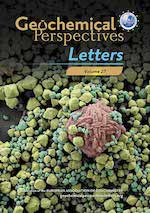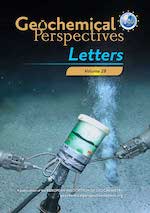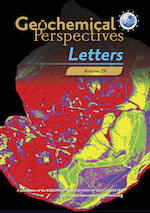Constant iron isotope composition of the upper continental crust over the past 3 Gyr
Affiliations | Corresponding Author | Cite as | Funding information- Share this article





-
Article views:2,362Cumulative count of HTML views and PDF downloads.
- Download Citation
- Rights & Permissions
top
Abstract
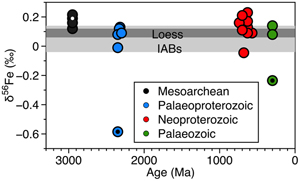
Dauphas, N., John, S.G., Rouxel, O. (2017) Iron Isotope Systematics. In: Fang-Zhen, T., James, W., Nicolas, D. (Eds.) Non-Traditional Stable Isotopes. Mineralogical Society of America and Geochemical Society, Washington, DC, United States, 415–510. https://doi.org/10.1515/9783110545630-012
, and references therein). There is no obvious correlation between δ56Fe of the glacial diamictites and the CIA. Our data suggest that the Fe isotope composition of the upper continental crust has been relatively constant throughout Earth history and that chemical weathering is not important in producing Fe isotope variations in the upper continental crust. Pre-Great Oxidation Event (GOE) anoxic weathering, when iron was soluble in its divalent state, did not generate different Fe isotopic signatures from the post-GOE oxidative weathering environment in the upper continental crust. Therefore, the large Fe isotopic fractionations observed in various marine sedimentary records are likely due to processes occurring in the oceans (e.g., biological activity) rather than abiotic redox reactions on the continents.Figures
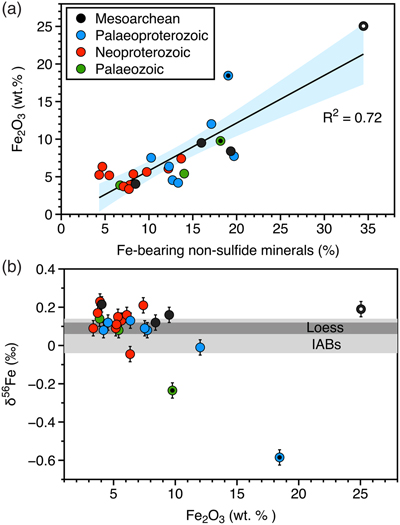 Figure 1 (a) Total iron content (Fe2O3, wt. %) vs. Fe-bearing non-sulfide minerals (%) in all glacial diamictite composites. (b) Plot of δ56Fe vs. total iron content (Fe2O3, wt. %) in all diamictites. Error bars represent two standard derivations. Black lines denote linear fit with light blue fields indicating 95 % confidence interval of fitting. The horizontal gray bars indicate the UCC values (dark gray, 2σ) calculated from loess (Gong et al., 2017) and the juvenile bulk crust values (light gray, 2σ) from IABs (Dauphas et al., 2009), respectively. Two outliers with distinctive Fe isotope compositions are shown with a black dot in the centre of symbols, whereas the Mozaan sample is marked with a white dot. | 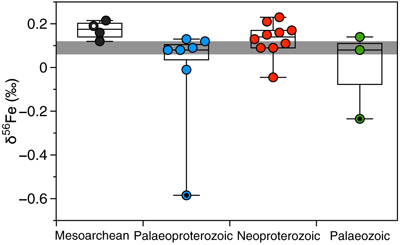 Figure 2 Box and whiskers plot of δ56Fe in diamictite composites of four age groups: the Mesoarchean, Palaeoproterozoic, Neoproterozoic, and Palaeozoic groups. Each individual box includes 50 % of samples and whiskers mark the maximum and minimum of the bin population. The horizontal gray bar indicates the UCC values (2σ) calculated from loess (Gong et al., 2017). | 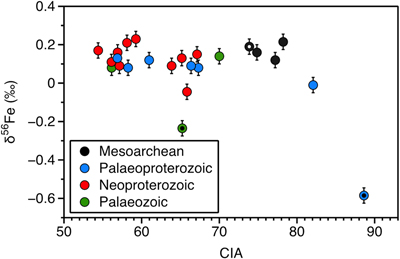 Figure 3 Plot of δ56Fe vs. CIA (chemical index of alteration) in diamictites. CIA is calculated as defined in molar ratio as [Al2O3/(Al2O3 + CaO* + Na2O + K2O)] × 100, where CaO* is corrected to remove the contribution from carbonate and apatite (Nesbitt and Young, 1982). CIA data for diamictite plotted here are from Gaschnig et al. (2016). |
| Figure 1 | Figure 2 | Figure 3 |
top
Introduction
Iron is the fourth most abundant element in the continental crust (Rudnick and Gao, 2003
Rudnick, R.L., Gao, S. (2003) 3.01 - Composition of the Continental Crust. In: Holland, H.D., Turekian, K.K. (Eds.) Treatise on Geochemistry. Volume 3: The Crust. Elsevier-Pergamon, Oxford, 1–64. https://doi.org/10.1016/B0-08-043751-6/03016-4
) and it influences global climate and biogeochemical cycles in the ocean (Martin, 1990Martin, J.H. (1990) Glacial-interglacial CO2 change: The Iron Hypothesis. Paleoceanography 5, 1–13. https://doi.org/10.1029/PA005i001p00001
). Continental inputs, including riverine inputs and atmospheric dust, are dominant sources (>95 %) of iron in the modern ocean (Fantle and DePaolo, 2004Fantle, M.S., DePaolo, D.J. (2004) Iron isotopic fractionation during continental weathering. Earth and Planetary Science Letters 228, 547–562. https://doi.org/10.1016/j.epsl.2004.10.013
). Thus, understanding how continental inputs may have changed through time is important in understanding the secular evolution of the marine iron cycle. Continental weathering in the modern oxidising environment transports the majority of iron as detrital phases and little iron in Fe (III) colloidal form, leading to a very low dissolved iron concentration in modern seawater (Fantle and DePaolo, 2004Fantle, M.S., DePaolo, D.J. (2004) Iron isotopic fractionation during continental weathering. Earth and Planetary Science Letters 228, 547–562. https://doi.org/10.1016/j.epsl.2004.10.013
; Johnson et al., 2020Johnson, C., Beard, B., Weyer, S. (2020) The Modern Surficial World, Iron Geochemistry: An Isotopic Perspective. Springer International Publishing, Switzerland, 149–214. https://doi.org/10.1007/978-3-030-33828-2_5
). However, the mechanism(s) of iron transportation in the geological past, especially before the Great Oxidation Event (GOE), was different due to very low oxygen levels in the atmosphere and oceans. Then, iron was transported in dissolved divalent form and deposited on the ocean floor in the form of marine sedimentary rocks such as iron formations (Holland, 2006Holland, H.D. (2006) The oxygenation of the atmosphere and oceans. Philosophical Transactions of the Royal Society B: Biological Sciences 361, 903–915. https://doi.org/10.1098/rstb.2006.1838
). Overall, it is important to understand the secular evolution of the δ56Fe composition of the continental crust and potential effects of varying oxidation levels on chemical weathering signatures.Iron isotopes in the upper continental crust (UCC) were first determined in the pioneering work of Beard et al. (1999)
Beard, B.L., Johnson, C.M., Cox, L., Sun, H., Nealson, K.H., Aguilar, C. (1999) Iron Isotope Biosignatures. Science 285, 1889–1892. https://doi.org/10.1126/science.285.5435.1889
and summarised in Beard and Johnson (2004)Beard, B.L., Johnson, C.M. (2004) Fe Isotope Variations in the Modern and Ancient Earth and Other Planetary Bodies. Reviews in Mineralogy and Geochemistry 55, 319–357. https://doi.org/10.2138/gsrmg.55.1.319
, where they estimated the average δ56Fe of UCC as 0.11 ± 0.1 ‰, based on the Fe isotopic compositions of clastic sedimentary rocks and suspended loads from rivers. More recently, Gong et al. (2017)Gong, Y., Xia, Y., Huang, F., Yu, H. (2017) Average iron isotopic compositions of the upper continental crust: constrained by loess from the Chinese Loess Plateau. Acta Geochimica 36, 125–131. https://doi.org/10.1007/s11631-016-0131-5
measured Fe isotopic compositions in loess-paleosols horizons, which have relatively homogeneous Fe isotopic compositions with δ56Fe ranging from 0.06 ‰ to 0.12 ‰, overlapping the previously determined UCC values. The UCC δ56Fe values are on the higher end but mostly within the range observed for mantle/primitive basalts, as constrained by island arc basalts (IABs) (Dauphas et al., 2009Dauphas, N., Craddock, P.R., Asimow, P.D., Bennett, V.C., Nutman, A.P., Ohnenstetter, D. (2009) Iron isotopes may reveal the redox conditions of mantle melting from Archean to Present. Earth and Planetary Science Letters 288, 255–267. https://doi.org/10.1016/j.epsl.2009.09.029
).Potential weathering influences on continental crustal Fe isotope compositions have been investigated through case studies of weathering profiles and soils in modern oxic environments (e.g., Wiederhold et al., 2007
Wiederhold, J.G., Teutsch, N., Kraemer, S.M., Halliday, A.N., Kretzschmar, R. (2007) Iron Isotope Fractionation during Pedogenesis in Redoximorphic Soils. Soil Science Society of America Journal 71, 1840–1850. https://doi.org/10.2136/sssaj2006.0379
; Kiczka et al., 2011Kiczka, M., Wiederhold, J.G., Frommer, J., Voegelin, A., Kraemer, S.M., Bourdon, B., Kretzschmar, R. (2011) Iron speciation and isotope fractionation during silicate weathering and soil formation in an alpine glacier forefield chronosequence. Geochimica et Cosmochimica Acta 75, 5559–5573. https://doi.org/10.1016/j.gca.2011.07.008
; Yesavage et al., 2012Yesavage, T., Fantle, M.S., Vervoort, J., Mathur, R., Jin, L., Liermann, L.J., Brantley, S.L. (2012) Fe cycling in the Shale Hills Critical Zone Observatory, Pennsylvania: An analysis of biogeochemical weathering and Fe isotope fractionation. Geochimica et Cosmochimica Acta 99, 18–38. https://doi.org/10.1016/j.gca.2012.09.029
). Although the exact mechanisms of Fe isotope fractionation in the upper continental crust may vary from case to case, the general direction is that weathering produces isotopically light dissolved Fe, leaving behind a sightly heavy regolith (Fantle and DePaolo, 2004Fantle, M.S., DePaolo, D.J. (2004) Iron isotopic fractionation during continental weathering. Earth and Planetary Science Letters 228, 547–562. https://doi.org/10.1016/j.epsl.2004.10.013
). By contrast, weathering under anoxic conditions may have been very different from modern environments and changes of weathering patterns on the continents from pre-GOE to the present may be recorded by the weathered upper continental crust. However, few studies of the effects of weathering on Fe isotopes in pre-GOE anoxic environments exist. For example, previous paleosol studies all show that chemical weathering preferentially removed isotopically light iron and left a heavy isotopic composition in regolith/paleosol. Overall, the reported magnitudes of isotopic fractionation are larger during oxidative weathering (δ56Fe = −0.8 ‰ to +1.2 ‰) compared to anoxic weathering (δ56Fe = −0.06 ‰ to +0.51 ‰), while the direction remains the same (e.g., Wiederhold et al., 2007Wiederhold, J.G., Teutsch, N., Kraemer, S.M., Halliday, A.N., Kretzschmar, R. (2007) Iron Isotope Fractionation during Pedogenesis in Redoximorphic Soils. Soil Science Society of America Journal 71, 1840–1850. https://doi.org/10.2136/sssaj2006.0379
; Yamaguchi et al., 2007Yamaguchi, K.E., Johnson, C.M., Beard, B.L., Beukes, N.J., Gutzmer, J., Ohmoto, H. (2007) Isotopic evidence for iron mobilization during Paleoproterozoic lateritization of the Hekpoort paleosol profile from Gaborone, Botswana. Earth and Planetary Science Letters 256, 577–587. https://doi.org/10.1016/j.epsl.2007.02.010
; Babechuk et al., 2019Babechuk, M.G., Weimar, N.E., Kleinhanns, I.C., Eroglu, S., Swanner, E.D., Kenny, G.G., Kamber, B.S., Schoenberg, R. (2019) Pervasively anoxic surface conditions at the onset of the Great Oxidation Event: New multi-proxy constraints from the Cooper Lake paleosol. Precambrian Research 323, 126–163. https://doi.org/10.1016/j.precamres.2018.12.029
; Heard et al., 2021Heard, A.W., Aarons, S.M., Hofmann, A., He, X., Ireland, T., Bekker, A., Qin, L., Dauphas, N. (2021) Anoxic continental surface weathering recorded by the 2.95 Ga Denny Dalton Paleosol (Pongola Supergroup, South Africa). Geochimica et Cosmochimica Acta 295, 1–23. https://doi.org/10.1016/j.gca.2020.12.005
). Nonetheless, there is no systematic study on how different chemical weathering conditions before and after the GOE may have influenced the Fe isotopic composition of the upper continental crust. Glacial diamictites may be useful proxies of the exposed upper continental crust because they derive from physical erosion of large continental areas with little associated (syn-depositional) chemical weathering or post-depositional weathering, though they do carry a weathering signature derived from the exposed upper continental crust (Li et al., 2016Li, S., Gaschnig, R.M., Rudnick, R.L. (2016) Insights into chemical weathering of the upper continental crust from the geochemistry of ancient glacial diamictites: Geochimica et Cosmochimica Acta 176, 96–117. https://doi.org/10.1016/j.gca.2015.12.012
).The objective of this study is to understand how Fe isotope compositions in the upper continental crust may have changed through time and whether changes in chemical weathering conditions on the continents influenced Fe isotope compositions of the upper continental crust. Here, we report Fe isotope compositions for twenty four glacial diamictite composites (including 143 individual diamictite samples, Table S-1; Gaschnig et al., 2016
Gaschnig, R.M., Rudnick, R.L., McDonough, W.F., Kaufman, A.J., Valley, J.W., Hu, Z., Gao, S., Beck, M.L. (2016) Compositional evolution of the upper continental crust through time, as constrained by ancient glacial diamictites. Geochimica et Cosmochimica Acta 186, 316–343. https://doi.org/10.1016/j.gca.2016.03.020
) with depositional ages ranging from Mesoarchean to the Palaeozoic eras, which serve as proxies of the upper continental crust to track how δ56Fe may have changed in the continental crust through time.top
Samples and Methods
The well-characterised glacial diamictite composites (Gaschnig et al., 2016
Gaschnig, R.M., Rudnick, R.L., McDonough, W.F., Kaufman, A.J., Valley, J.W., Hu, Z., Gao, S., Beck, M.L. (2016) Compositional evolution of the upper continental crust through time, as constrained by ancient glacial diamictites. Geochimica et Cosmochimica Acta 186, 316–343. https://doi.org/10.1016/j.gca.2016.03.020
) are composed of material derived from the abrasion and erosion of soil and bedrock that was transported by glaciers and sea ice. Glacial diamictites are poorly sorted and were deposited either on the continent or in a shallow marine environment. Because glacial sediments derive from physical erosion of large continental areas by glaciers with little syn/post-depositional weathering, Goldschmidt (1933)Goldschmidt, V.M. (1933) Grundlagen der quantitativen Geochemie. Fortschritte der Mineralogie, Kristallographie und Petrographie 17, 112.
first suggested that they could be robust proxies to estimate the average upper continental crust composition.Glacial deposits occur in five broad geological periods: the Mesoarchean (ca. 2900 Ma), Palaeoproterozoic (2400–2200 Ma), Neoproterozoic (750–550 Ma), Palaeozoic (a short glacial event at 450 Ma and a longer one at 330–300 Ma), and Cenozoic (2.58–0.01 Ma) (Gaschnig et al., 2014
Gaschnig, R.M., Rudnick, R.L., McDonough, W.F., Kaufman, A.J., Hu, Z., Gao, S. (2014) Onset of oxidative weathering of continents recorded in the geochemistry of ancient glacial diamictites. Earth and Planetary Science Letters 408, 87–99. https://doi.org/10.1016/j.epsl.2014.10.002
, 2016Gaschnig, R.M., Rudnick, R.L., McDonough, W.F., Kaufman, A.J., Valley, J.W., Hu, Z., Gao, S., Beck, M.L. (2016) Compositional evolution of the upper continental crust through time, as constrained by ancient glacial diamictites. Geochimica et Cosmochimica Acta 186, 316–343. https://doi.org/10.1016/j.gca.2016.03.020
; and references therein). The glacial diamictites investigated in this study come from four main geological intervals, including the Mesoarchean, Palaeoproterozic, Neoproterozic, and Palaeozoic eras. Individual diamictite samples (n = 143) were crushed in a ceramic jaw crusher, where the resulting chips were handpicked to concentrate the fine grained matrix and exclude clasts larger than 1 mm in diameter at the University of Maryland (Gaschnig et al., 2014Gaschnig, R.M., Rudnick, R.L., McDonough, W.F., Kaufman, A.J., Hu, Z., Gao, S. (2014) Onset of oxidative weathering of continents recorded in the geochemistry of ancient glacial diamictites. Earth and Planetary Science Letters 408, 87–99. https://doi.org/10.1016/j.epsl.2014.10.002
). These chips were then ground into powders in a ceramic mill. All twenty four diamictite composites were made by weighing out equal weight aliquots (±0.1 grams) of powders from each individual stratigraphic formation listed in Gaschnig et al. (2016)Gaschnig, R.M., Rudnick, R.L., McDonough, W.F., Kaufman, A.J., Valley, J.W., Hu, Z., Gao, S., Beck, M.L. (2016) Compositional evolution of the upper continental crust through time, as constrained by ancient glacial diamictites. Geochimica et Cosmochimica Acta 186, 316–343. https://doi.org/10.1016/j.gca.2016.03.020
, as well as in Supplementary Information (Table S-1).Iron isotope analyses were performed at the Carnegie Institution for Science. A brief description of sample dissolution, column chemistry, and instrumental analysis is provided in the Supplementary Information. Purified Fe solutions (∼4 ppm Fe in 0.4 M HNO3) were analysed using a Nu Plasma II Multi-Collector Inductively Coupled Plasma Mass Spectrometer (MC-ICP-MS). Standard bracketing, using IRMM524a (made from IRMM® certified Reference iron foil), was performed for all analyses. The Fe isotope composition of IRMM524a is identical to that of previously used international standard, IRMM-014. Therefore, the Fe isotope composition is reported as δ56Fe, where δ56Fesample = [(56Fe/54Fe)sample/(56Fe/54Fe)IRMM-014 – 1] × 1000. The external precision and accuracy of the measurements were evaluated by repeatedly running two USGS rock standards, BIR-1 (Icelandic basalt) and MAG-1 (marine mud), respectively (Table S-2). BIR-1 yielded δ56Fe = 0.05 ± 0.03 ‰ (2σ, n = 5; cf. 0.03–0.06 ‰ in the literature; GeoReM database, http://georem.mpch-mainz.gwdg.de/), and MAG-1 yielded δ56Fe = 0.11 ± 0.04 ‰ (2σ, n = 5; cf. 0.09–0.13 ‰ in the GeoReM database).
top
Secular Evolution of Fe Isotope Composition of the Upper Continental Crust
Iron contents and isotopic compositions of the diamictite composites are reported in Table S-1. Total Fe concentrations (Fe2O3) in the composites vary considerably, from 3 wt. % to 25 wt. % and correlate with the proportions of Fe-bearing minerals (Fig. 1a), where Fe-containing non-sulfide minerals are defined using the sum of the following Fe-bearing silicates and oxides: chlorite, biotite, amphibole, hematite, and magnetite (Table S-3). By contrast, the diamictites show a limited spread in their Fe isotope compositions (−0.59 ‰ to +0.23 ‰; average, 0.08 ± 0.34 ‰ [2σ]), with no correlation between δ56Fe values and total iron concentrations (Fig. 1b). This range overlaps with the values of juvenile continental crustal material: IABs and the present day upper continental crust (UCC) both show narrow ranges in δ56Fe from −0.04 ‰ to +0.14 ‰ (Dauphas et al., 2009
Dauphas, N., Craddock, P.R., Asimow, P.D., Bennett, V.C., Nutman, A.P., Ohnenstetter, D. (2009) Iron isotopes may reveal the redox conditions of mantle melting from Archean to Present. Earth and Planetary Science Letters 288, 255–267. https://doi.org/10.1016/j.epsl.2009.09.029
) and from +0.06 ‰ to +0.12 ‰ (Gong et al., 2017Gong, Y., Xia, Y., Huang, F., Yu, H. (2017) Average iron isotopic compositions of the upper continental crust: constrained by loess from the Chinese Loess Plateau. Acta Geochimica 36, 125–131. https://doi.org/10.1007/s11631-016-0131-5
), respectively.
Figure 1 (a) Total iron content (Fe2O3, wt. %) vs. Fe-bearing non-sulfide minerals (%) in all glacial diamictite composites. (b) Plot of δ56Fe vs. total iron content (Fe2O3, wt. %) in all diamictites. Error bars represent two standard derivations. Black lines denote linear fit with light blue fields indicating 95 % confidence interval of fitting. The horizontal gray bars indicate the UCC values (dark gray, 2σ) calculated from loess (Gong et al., 2017
Gong, Y., Xia, Y., Huang, F., Yu, H. (2017) Average iron isotopic compositions of the upper continental crust: constrained by loess from the Chinese Loess Plateau. Acta Geochimica 36, 125–131. https://doi.org/10.1007/s11631-016-0131-5
) and the juvenile bulk crust values (light gray, 2σ) from IABs (Dauphas et al., 2009Dauphas, N., Craddock, P.R., Asimow, P.D., Bennett, V.C., Nutman, A.P., Ohnenstetter, D. (2009) Iron isotopes may reveal the redox conditions of mantle melting from Archean to Present. Earth and Planetary Science Letters 288, 255–267. https://doi.org/10.1016/j.epsl.2009.09.029
), respectively. Two outliers with distinctive Fe isotope compositions are shown with a black dot in the centre of symbols, whereas the Mozaan sample is marked with a white dot.Major element data (Gaschnig et al., 2016
Gaschnig, R.M., Rudnick, R.L., McDonough, W.F., Kaufman, A.J., Valley, J.W., Hu, Z., Gao, S., Beck, M.L. (2016) Compositional evolution of the upper continental crust through time, as constrained by ancient glacial diamictites. Geochimica et Cosmochimica Acta 186, 316–343. https://doi.org/10.1016/j.gca.2016.03.020
) and new Si isotope data (Murphy et al., 2022Murphy, M.E., Savage, P.S., Gardiner, N.J., Prave, A.R., Gaschnig, R.M., Rudnick, R.L. (2022) Homogenising the upper continental crust: The Si isotope evolution of the crust recorded by ancient glacial diamictites. Earth and Planetary Science Letters 591, 117620. https://doi.org/10.1016/j.epsl.2022.117620
) show that banded iron formation (BIF) influenced some composites, including the Archean/Palaeoproterozoic Mozaan and Makganyene diamictites, which have distinctly lower δ30Si and higher Fe2O3. The Palaeozoic Dwyka West sample, which derives from an ancient provenance (Gaschnig et al., 2022Gaschnig, R.M., Horon, M., Rudnick, R.L., Vervoort, J., Fisher, C. (2022) History of crustal growth in Africa and the Americas from detrital zircons and Nd isotopes in glacial diamictites. Precambrian Research, 373, 106641. https://doi.org/10.1016/j.precamres.2022.106641
), contains clasts of BIF and moderately high Fe2O3 (9.8 wt. %) and has slightly lower δ30Si. BIF shows great variability in δ56Fe (Heard and Dauphas, 2020Heard, A.W., Dauphas, N. (2020) Constraints on the coevolution of oxic and sulfidic ocean iron sinks from Archean–Paleoproterozoic iron isotope records. Geology 48, 358–362. https://doi.org/10.1130/G46951.1
), and two of the samples that show evidence for BIF based on low δ30Si and high Fe2O3 also show low δ56Fe (i.e. Makganyene and Dwyka West). By contrast, the Mozaan composite, which has the highest Fe2O3 and lowest δ30Si has ‘normal’ δ56Fe. These observations explain the lowest two δ56Fe values in the Makganyene and Dwyka West composites. We exclude these three samples (Mozaan, Makganyene, and Dwyka West) when calculating the average UCC Fe isotope compositions.The data show that the Fe isotope composition of the upper continental crust has not varied significantly since 2.9 Ga (Fig. 2). The δ56Fe values in the Archean diamictite composites appear higher (δ56Feave = 0.17 ‰) compared to those of the Palaeoproterozoic composites (δ56Feave = 0.11 ‰) (Fig. 2) (excluding the Makganyene sample with known BIF influence). However, a Student’s t-test yields a p value greater than 0.05, demonstrating that there is no difference between the means of the two groups.

Figure 2 Box and whiskers plot of δ56Fe in diamictite composites of four age groups: the Mesoarchean, Palaeoproterozoic, Neoproterozoic, and Palaeozoic groups. Each individual box includes 50 % of samples and whiskers mark the maximum and minimum of the bin population. The horizontal gray bar indicates the UCC values (2σ) calculated from loess (Gong et al., 2017
Gong, Y., Xia, Y., Huang, F., Yu, H. (2017) Average iron isotopic compositions of the upper continental crust: constrained by loess from the Chinese Loess Plateau. Acta Geochimica 36, 125–131. https://doi.org/10.1007/s11631-016-0131-5
).top
Weathering Signatures and Their Influence on the Secular Evolution of Fe Isotopes in UCC
Using the diamictite’s Fe isotope compositions and excluding the three samples having a BIF influence, we calculate an average upper continental crust δ56Fe value of 0.12 ± 0.13 ‰ (2σ), which represents the UCC over Earth history. This new estimate is within the uncertainty of the recently estimated average δ56Fe of 0.09 ± 0.03‰ (2σ) for the present day upper continental crust based on loess (Gong et al., 2017
Gong, Y., Xia, Y., Huang, F., Yu, H. (2017) Average iron isotopic compositions of the upper continental crust: constrained by loess from the Chinese Loess Plateau. Acta Geochimica 36, 125–131. https://doi.org/10.1007/s11631-016-0131-5
). IABs with δ56Fe = 0.06 ± 0.08 ‰ (2σ), which are possible analogues of the juvenile continental crust, have near-chondritic iron isotope compositions (δ56Fe = −0.005 ± 0.006 ‰) (Dauphas et al., 2009Dauphas, N., Craddock, P.R., Asimow, P.D., Bennett, V.C., Nutman, A.P., Ohnenstetter, D. (2009) Iron isotopes may reveal the redox conditions of mantle melting from Archean to Present. Earth and Planetary Science Letters 288, 255–267. https://doi.org/10.1016/j.epsl.2009.09.029
, 2017Dauphas, N., John, S.G., Rouxel, O. (2017) Iron Isotope Systematics. In: Fang-Zhen, T., James, W., Nicolas, D. (Eds.) Non-Traditional Stable Isotopes. Mineralogical Society of America and Geochemical Society, Washington, DC, United States, 415–510. https://doi.org/10.1515/9783110545630-012
). Student’s t-test results show that the UCC δ56Fe from these diamictites (δ56Feave = 0.12 ‰) are statistically different (p < 0.05) from juvenile crust as sampled by IABs (δ56Feave = 0.06 ‰). These slightly heavier upper continental crustal values may reflect the influence of chemical weathering, which produces heavier Fe isotope compositions in the regolith compared to that of the juvenile crust (Fantle and DePaolo, 2004Fantle, M.S., DePaolo, D.J. (2004) Iron isotopic fractionation during continental weathering. Earth and Planetary Science Letters 228, 547–562. https://doi.org/10.1016/j.epsl.2004.10.013
).As demonstrated earlier, total Fe concentrations correlate well with Fe-containing silicate minerals and oxides (Fig. 1a), and do not correlate with total sulfur content (Fig. S-1). Thus, in contrast to the isotopes of elements controlled by sulfide weathering such as Ni (Wang et al., 2019
Wang, S.-J., Rudnick, R.L., Gaschnig, R.M., Wang, H., Wasylenki, L.E. (2019) Methanogenesis sustained by sulfide weathering during the Great Oxidation Event. Nature Geoscience 12, 296–300. https://doi.org/10.1038/s41561-019-0320-z
), sulfide weathering did not significantly affect the Fe isotopic compositions in the pre-GOE samples. Therefore, anoxic weathering appears to generate similar Fe isotope signatures as the post-GOE oxidative weathering environment in the upper continental crust.There is no correlation between δ56Fe and CIA in the diamictites (Fig. 3). While chemical weathering produces an isotopically heavier regolith, as seen by the slightly higher δ56Fe values in the diamictites and other UCC materials compared to the juvenile crust represented by IABs, this has only resulted in a 0.06 ‰ difference between average UCC and juvenile crust δ56Fe. Therefore, we conclude that chemical weathering has only a minor influence on the Fe isotope composition of the upper continental crust.

Figure 3 Plot of δ56Fe vs. CIA (chemical index of alteration) in diamictites. CIA is calculated as defined in molar ratio as [Al2O3/(Al2O3 + CaO* + Na2O + K2O)] × 100, where CaO* is corrected to remove the contribution from carbonate and apatite (Nesbitt and Young, 1982
Nesbitt, H.W., Young, G.M. (1982) Early Proterozoic climates and plate motions inferred from major element chemistry of lutites. Nature 299, 715–717. https://doi.org/10.1038/299715a0
). CIA data for diamictite plotted here are from Gaschnig et al. (2016)Gaschnig, R.M., Rudnick, R.L., McDonough, W.F., Kaufman, A.J., Valley, J.W., Hu, Z., Gao, S., Beck, M.L. (2016) Compositional evolution of the upper continental crust through time, as constrained by ancient glacial diamictites. Geochimica et Cosmochimica Acta 186, 316–343. https://doi.org/10.1016/j.gca.2016.03.020
.top
Conclusions
Glacial diamictites are faithful recorders of the upper continental crust composition, which has been through chemical weathering compared to the juvenile crust. Their δ56Fe values do not vary with depositional age (from ∼3 Ga onwards), indicating that changes in the oxidation state have no bearing on Fe isotopic fractionation during chemical weathering. Thus, the large Fe isotopic fractionation in marine sedimentary records (Heard and Dauphas, 2020
Heard, A.W., Dauphas, N. (2020) Constraints on the coevolution of oxic and sulfidic ocean iron sinks from Archean–Paleoproterozoic iron isotope records. Geology 48, 358–362. https://doi.org/10.1130/G46951.1
) is likely due to authigenic processes occurring in the oceans and not changes in the continental input to the oceans.top
Acknowledgements
We are grateful to Tim Mock and Corliss Sio for assistance with the MC-ICP-MS method development and analyses, and Mary Horan for help in the clean lab. We thank the editor for her efficient handling of the paper and insightful comments from two reviewers, which have helped us improve this manuscript. This work was supported by the University of North Carolina at Chapel Hill, the Carnegie Institution for Science, the University of Maryland, College Park, China University of Geosciences, Wuhan, and NSF grant EAR-1321954 to RLR and RMG. RMH acknowledges support for deep-time research from the Keck Foundation, the Templeton Foundation, the Alfred P. Sloan Foundation, and the NASA Astrobiology Institute ENIGMA team (80NSSC18M0093).
Editor: Helen Williams
top
References
Babechuk, M.G., Weimar, N.E., Kleinhanns, I.C., Eroglu, S., Swanner, E.D., Kenny, G.G., Kamber, B.S., Schoenberg, R. (2019) Pervasively anoxic surface conditions at the onset of the Great Oxidation Event: New multi-proxy constraints from the Cooper Lake paleosol. Precambrian Research 323, 126–163. https://doi.org/10.1016/j.precamres.2018.12.029
 Show in context
Show in context Overall, the reported magnitudes of isotopic fractionation are larger during oxidative weathering (δ56Fe = −0.8 ‰ to +1.2 ‰) compared to anoxic weathering (δ56Fe = −0.06 ‰ to +0.51 ‰), while the direction remains the same (e.g., Wiederhold et al., 2007; Yamaguchi et al., 2007; Babechuk et al., 2019; Heard et al., 2021).
View in article
Beard, B.L., Johnson, C.M. (2004) Fe Isotope Variations in the Modern and Ancient Earth and Other Planetary Bodies. Reviews in Mineralogy and Geochemistry 55, 319–357. https://doi.org/10.2138/gsrmg.55.1.319
 Show in context
Show in context Iron isotopes in the upper continental crust (UCC) were first determined in the pioneering work of Beard et al. (1999) and summarised in Beard and Johnson (2004), where they estimated the average δ56Fe of UCC as 0.11 ± 0.1 ‰, based on the Fe isotopic compositions of clastic sedimentary rocks and suspended loads from rivers.
View in article
Beard, B.L., Johnson, C.M., Cox, L., Sun, H., Nealson, K.H., Aguilar, C. (1999) Iron Isotope Biosignatures. Science 285, 1889–1892. https://doi.org/10.1126/science.285.5435.1889
 Show in context
Show in context Iron isotopes in the upper continental crust (UCC) were first determined in the pioneering work of Beard et al. (1999) and summarised in Beard and Johnson (2004), where they estimated the average δ56Fe of UCC as 0.11 ± 0.1 ‰, based on the Fe isotopic compositions of clastic sedimentary rocks and suspended loads from rivers.
View in article
Dauphas, N., Craddock, P.R., Asimow, P.D., Bennett, V.C., Nutman, A.P., Ohnenstetter, D. (2009) Iron isotopes may reveal the redox conditions of mantle melting from Archean to Present. Earth and Planetary Science Letters 288, 255–267. https://doi.org/10.1016/j.epsl.2009.09.029
 Show in context
Show in context The UCC δ56Fe values are on the higher end but mostly within the range observed for mantle/primitive basalts, as constrained by island arc basalts (IABs) (Dauphas et al., 2009).
View in article
This range overlaps with the values of juvenile continental crustal material: IABs and the present day upper continental crust (UCC) both show narrow ranges in δ56Fe from −0.04 ‰ to +0.14 ‰ (Dauphas et al., 2009) and from +0.06 ‰ to +0.12 ‰ (Gong et al., 2017), respectively.
View in article
The horizontal gray bars indicate the UCC values (dark gray, 2σ) calculated from loess (Gong et al., 2017) and the juvenile bulk crust values (light gray, 2σ) from IABs (Dauphas et al., 2009), respectively.
View in article
IABs with δ56Fe = 0.06 ± 0.08 ‰ (2σ), which are possible analogues of the juvenile continental crust, have near-chondritic iron isotope compositions (δ56Fe = −0.005 ± 0.006 ‰) (Dauphas et al., 2009, 2017).
View in article
Dauphas, N., John, S.G., Rouxel, O. (2017) Iron Isotope Systematics. In: Fang-Zhen, T., James, W., Nicolas, D. (Eds.) Non-Traditional Stable Isotopes. Mineralogical Society of America and Geochemical Society, Washington, DC, United States, 415–510. https://doi.org/10.1515/9783110545630-012
 Show in context
Show in context Excluding three samples impacted by the incorporation of materials from Fe formations, the diamictites have an average δ56Fe of 0.12 ± 0.13 ‰ (2σ), overlapping the recent estimated average δ56Fe of 0.09 ± 0.03 ‰ (2 s.d.) in the upper continental crust (Dauphas et al., 2017, and references therein).
View in article
IABs with δ56Fe = 0.06 ± 0.08 ‰ (2σ), which are possible analogues of the juvenile continental crust, have near-chondritic iron isotope compositions (δ56Fe = −0.005 ± 0.006 ‰) (Dauphas et al., 2009, 2017).
View in article
Fantle, M.S., DePaolo, D.J. (2004) Iron isotopic fractionation during continental weathering. Earth and Planetary Science Letters 228, 547–562. https://doi.org/10.1016/j.epsl.2004.10.013
 Show in context
Show in context Continental inputs, including riverine inputs and atmospheric dust, are dominant sources (>95 %) of iron in the modern ocean (Fantle and DePaolo, 2004).
View in article
Continental weathering in the modern oxidising environment transports the majority of iron as detrital phases and little iron in Fe (III) colloidal form, leading to a very low dissolved iron concentration in modern seawater (Fantle and DePaolo, 2004; Johnson et al., 2020).
View in article
Although the exact mechanisms of Fe isotope fractionation in the upper continental crust may vary from case to case, the general direction is that weathering produces isotopically light dissolved Fe, leaving behind a sightly heavy regolith (Fantle and DePaolo, 2004).
View in article
These slightly heavier upper continental crustal values may reflect the influence of chemical weathering, which produces heavier Fe isotope compositions in the regolith compared to that of the juvenile crust (Fantle and DePaolo, 2004).
View in article
Gaschnig, R.M., Rudnick, R.L., McDonough, W.F., Kaufman, A.J., Hu, Z., Gao, S. (2014) Onset of oxidative weathering of continents recorded in the geochemistry of ancient glacial diamictites. Earth and Planetary Science Letters 408, 87–99. https://doi.org/10.1016/j.epsl.2014.10.002
 Show in context
Show in context Glacial deposits occur in five broad geological periods: the Mesoarchean (ca. 2900 Ma), Palaeoproterozoic (2400–2200 Ma), Neoproterozoic (750–550 Ma), Palaeozoic (a short glacial event at 450 Ma and a longer one at 330–300 Ma), and Cenozoic (2.58–0.01 Ma) (Gaschnig et al., 2014, 2016; and references therein).
View in article
Individual diamictite samples (n = 143) were crushed in a ceramic jaw crusher, where the resulting chips were handpicked to concentrate the fine grained matrix and exclude clasts larger than 1 mm in diameter at the University of Maryland (Gaschnig et al., 2014).
View in article
Gaschnig, R.M., Rudnick, R.L., McDonough, W.F., Kaufman, A.J., Valley, J.W., Hu, Z., Gao, S., Beck, M.L. (2016) Compositional evolution of the upper continental crust through time, as constrained by ancient glacial diamictites. Geochimica et Cosmochimica Acta 186, 316–343. https://doi.org/10.1016/j.gca.2016.03.020
 Show in context
Show in context The objective of this study is to understand how Fe isotope compositions in the upper continental crust may have changed through time and whether changes in chemical weathering conditions on the continents influenced Fe isotope compositions of the upper continental crust. Here, we report Fe isotope compositions for twenty four glacial diamictite composites (including 143 individual diamictite samples, Table S-1; Gaschnig et al., 2016) with depositional ages ranging from Mesoarchean to the Palaeozoic eras, which serve as proxies of the upper continental crust to track how δ56Fe may have changed in the continental crust through time.
View in article
The well-characterised glacial diamictite composites (Gaschnig et al., 2016) are composed of material derived from the abrasion and erosion of soil and bedrock that was transported by glaciers and sea ice.
View in article
Glacial deposits occur in five broad geological periods: the Mesoarchean (ca. 2900 Ma), Palaeoproterozoic (2400–2200 Ma), Neoproterozoic (750–550 Ma), Palaeozoic (a short glacial event at 450 Ma and a longer one at 330–300 Ma), and Cenozoic (2.58–0.01 Ma) (Gaschnig et al., 2014, 2016; and references therein).
View in article
These chips were then ground into powders in a ceramic mill. All twenty four diamictite composites were made by weighing out equal weight aliquots (±0.1 grams) of powders from each individual stratigraphic formation listed in Gaschnig et al. (2016), as well as in Supplementary Information (Table S-1)
View in article
Major element data (Gaschnig et al., 2016) and new Si isotope data (Murphy et al., 2022) show that banded iron formation (BIF) influenced some composites, including the Archean/Palaeoproterozoic Mozaan and Makganyene diamictites, which have distinctly lower δ30Si and higher Fe2O3
View in article
CIA is calculated as defined in molar ratio as [Al2O3/(Al2O3 + CaO* + Na2O + K2O)] × 100, where CaO* is corrected to remove the contribution from carbonate and apatite (Nesbitt and Young, 1982). CIA data for diamictite plotted here are from Gaschnig et al. (2016).
View in article
Gaschnig, R.M., Horon, M., Rudnick, R.L., Vervoort, J., Fisher, C. (2022) History of crustal growth in Africa and the Americas from detrital zircons and Nd isotopes in glacial diamictites. Precambrian Research, 373, 106641. https://doi.org/10.1016/j.precamres.2022.106641
 Show in context
Show in context The Palaeozoic Dwyka West sample, which derives from an ancient provenance (Gaschnig et al., 2022), contains clasts of BIF and moderately high Fe2O3 (9.8 wt. %) and has slightly lower δ30Si. BIF shows great variability in δ56Fe (Heard and Dauphas, 2020), and two of the samples that show evidence for BIF based on low δ30Si and high Fe2O3 also show low δ56Fe (i.e. Makganyene and Dwyka West).
View in article
Goldschmidt, V.M. (1933) Grundlagen der quantitativen Geochemie. Fortschritte der Mineralogie, Kristallographie und Petrographie 17, 112.
 Show in context
Show in context Because glacial sediments derive from physical erosion of large continental areas by glaciers with little syn/post-depositional weathering, Goldschmidt (1933) first suggested that they could be robust proxies to estimate the average upper continental crust composition.
View in article
Gong, Y., Xia, Y., Huang, F., Yu, H. (2017) Average iron isotopic compositions of the upper continental crust: constrained by loess from the Chinese Loess Plateau. Acta Geochimica 36, 125–131. https://doi.org/10.1007/s11631-016-0131-5
 Show in context
Show in context More recently, Gong et al. (2017) measured Fe isotopic compositions in loess-paleosols horizons, which have relatively homogeneous Fe isotopic compositions with δ56Fe ranging from 0.06 ‰ to 0.12 ‰, overlapping the previously determined UCC values.
View in article
This range overlaps with the values of juvenile continental crustal material: IABs and the present day upper continental crust (UCC) both show narrow ranges in δ56Fe from −0.04 ‰ to +0.14 ‰ (Dauphas et al., 2009) and from +0.06 ‰ to +0.12 ‰ (Gong et al., 2017), respectively.
View in article
The horizontal gray bars indicate the UCC values (dark gray, 2σ) calculated from loess (Gong et al., 2017) and the juvenile bulk crust values (light gray, 2σ) from IABs (Dauphas et al., 2009), respectively.
View in article
The horizontal gray bar indicates the UCC values (2σ) calculated from loess (Gong et al., 2017).
View in article
This new estimate is within the uncertainty of the recently estimated average δ56Fe of 0.09 ± 0.03‰ (2σ) for the present day upper continental crust based on loess (Gong et al., 2017).
View in article
Heard, A.W., Dauphas, N. (2020) Constraints on the coevolution of oxic and sulfidic ocean iron sinks from Archean–Paleoproterozoic iron isotope records. Geology 48, 358–362. https://doi.org/10.1130/G46951.1
 Show in context
Show in context The Palaeozoic Dwyka West sample, which derives from an ancient provenance (Gaschnig et al., 2022), contains clasts of BIF and moderately high Fe2O3 (9.8 wt. %) and has slightly lower δ30Si. BIF shows great variability in δ56Fe (Heard and Dauphas, 2020), and two of the samples that show evidence for BIF based on low δ30Si and high Fe2O3 also show low δ56Fe (i.e. Makganyene and Dwyka West).
View in article
Thus, the large Fe isotopic fractionation in marine sedimentary records (Heard and Dauphas, 2020) is likely due to authigenic processes occurring in the oceans and not changes in the continental input to the oceans.
View in article
Heard, A.W., Aarons, S.M., Hofmann, A., He, X., Ireland, T., Bekker, A., Qin, L., Dauphas, N. (2021) Anoxic continental surface weathering recorded by the 2.95 Ga Denny Dalton Paleosol (Pongola Supergroup, South Africa). Geochimica et Cosmochimica Acta 295, 1–23. https://doi.org/10.1016/j.gca.2020.12.005
 Show in context
Show in context Overall, the reported magnitudes of isotopic fractionation are larger during oxidative weathering (δ56Fe = −0.8 ‰ to +1.2 ‰) compared to anoxic weathering (δ56Fe = −0.06 ‰ to +0.51 ‰), while the direction remains the same (e.g., Wiederhold et al., 2007; Yamaguchi et al., 2007; Babechuk et al., 2019; Heard et al., 2021).
View in article
Holland, H.D. (2006) The oxygenation of the atmosphere and oceans. Philosophical Transactions of the Royal Society B: Biological Sciences 361, 903–915. https://doi.org/10.1098/rstb.2006.1838
 Show in context
Show in context Then, iron was transported in dissolved divalent form and deposited on the ocean floor in the form of marine sedimentary rocks such as iron formations (Holland, 2006).
View in article
Johnson, C., Beard, B., Weyer, S. (2020) The Modern Surficial World, Iron Geochemistry: An Isotopic Perspective. Springer International Publishing, Switzerland, 149–214. https://doi.org/10.1007/978-3-030-33828-2_5
 Show in context
Show in context Continental weathering in the modern oxidising environment transports the majority of iron as detrital phases and little iron in Fe (III) colloidal form, leading to a very low dissolved iron concentration in modern seawater (Fantle and DePaolo, 2004; Johnson et al., 2020).
View in article
Kiczka, M., Wiederhold, J.G., Frommer, J., Voegelin, A., Kraemer, S.M., Bourdon, B., Kretzschmar, R. (2011) Iron speciation and isotope fractionation during silicate weathering and soil formation in an alpine glacier forefield chronosequence. Geochimica et Cosmochimica Acta 75, 5559–5573. https://doi.org/10.1016/j.gca.2011.07.008
 Show in context
Show in context Potential weathering influences on continental crustal Fe isotope compositions have been investigated through case studies of weathering profiles and soils in modern oxic environments (e.g., Wiederhold et al., 2007; Kiczka et al., 2011; Yesavage et al., 2012).
View in article
Li, S., Gaschnig, R.M., Rudnick, R.L. (2016) Insights into chemical weathering of the upper continental crust from the geochemistry of ancient glacial diamictites: Geochimica et Cosmochimica Acta 176, 96–117. https://doi.org/10.1016/j.gca.2015.12.012
 Show in context
Show in context Glacial diamictites may be useful proxies of the exposed upper continental crust because they derive from physical erosion of large continental areas with little associated (syn-depositional) chemical weathering or post-depositional weathering, though they do carry a weathering signature derived from the exposed upper continental crust (Li et al., 2016).
View in article
Martin, J.H. (1990) Glacial-interglacial CO2 change: The Iron Hypothesis. Paleoceanography 5, 1–13. https://doi.org/10.1029/PA005i001p00001
 Show in context
Show in context Iron is the fourth most abundant element in the continental crust (Rudnick and Gao, 2003) and it influences global climate and biogeochemical cycles in the ocean (Martin, 1990).
View in article
Murphy, M.E., Savage, P.S., Gardiner, N.J., Prave, A.R., Gaschnig, R.M., Rudnick, R.L. (2022) Homogenising the upper continental crust: The Si isotope evolution of the crust recorded by ancient glacial diamictites. Earth and Planetary Science Letters 591, 117620. https://doi.org/10.1016/j.epsl.2022.117620
 Show in context
Show in context Major element data (Gaschnig et al., 2016) and new Si isotope data (Murphy et al., 2022) show that banded iron formation (BIF) influenced some composites, including the Archean/Palaeoproterozoic Mozaan and Makganyene diamictites, which have distinctly lower δ30Si and higher Fe2O3
View in article
Nesbitt, H.W., Young, G.M. (1982) Early Proterozoic climates and plate motions inferred from major element chemistry of lutites. Nature 299, 715–717. https://doi.org/10.1038/299715a0
 Show in context
Show in context CIA is calculated as defined in molar ratio as [Al2O3/(Al2O3 + CaO* + Na2O + K2O)] × 100, where CaO* is corrected to remove the contribution from carbonate and apatite (Nesbitt and Young, 1982). CIA data for diamictite plotted here are from Gaschnig et al. (2016).
View in article
Rudnick, R.L., Gao, S. (2003) 3.01 - Composition of the Continental Crust. In: Holland, H.D., Turekian, K.K. (Eds.) Treatise on Geochemistry. Volume 3: The Crust. Elsevier-Pergamon, Oxford, 1–64. https://doi.org/10.1016/B0-08-043751-6/03016-4
 Show in context
Show in context Iron is the fourth most abundant element in the continental crust (Rudnick and Gao, 2003) and it influences global climate and biogeochemical cycles in the ocean (Martin, 1990).
View in article
Shields, W.R., Murphy, T.J., Catanzaro, E.J., Garner, E.L. (1966) Absolute Isotopic Abundance Ratios and the Atomic Weight of a Reference Sample of Chromium. Journal of Research of the National Bureau of Standards, Section A: Physics and Chemistry 70A, 193–197. https://doi.org/10.6028/jres.070A.016
Wang, S.-J., Rudnick, R.L., Gaschnig, R.M., Wang, H., Wasylenki, L.E. (2019) Methanogenesis sustained by sulfide weathering during the Great Oxidation Event. Nature Geoscience 12, 296–300. https://doi.org/10.1038/s41561-019-0320-z
 Show in context
Show in context Thus, in contrast to the isotopes of elements controlled by sulfide weathering such as Ni (Wang et al., 2019), sulfide weathering did not significantly affect the Fe isotopic compositions in the pre-GOE samples.
View in article
Wiederhold, J.G., Teutsch, N., Kraemer, S.M., Halliday, A.N., Kretzschmar, R. (2007) Iron Isotope Fractionation during Pedogenesis in Redoximorphic Soils. Soil Science Society of America Journal 71, 1840–1850. https://doi.org/10.2136/sssaj2006.0379
 Show in context
Show in context Potential weathering influences on continental crustal Fe isotope compositions have been investigated through case studies of weathering profiles and soils in modern oxic environments (e.g., Wiederhold et al., 2007; Kiczka et al., 2011; Yesavage et al., 2012).
View in article
Overall, the reported magnitudes of isotopic fractionation are larger during oxidative weathering (δ56Fe = −0.8 ‰ to +1.2 ‰) compared to anoxic weathering (δ56Fe = −0.06 ‰ to +0.51 ‰), while the direction remains the same (e.g., Wiederhold et al., 2007; Yamaguchi et al., 2007; Babechuk et al., 2019; Heard et al., 2021).
View in article
Yamaguchi, K.E., Johnson, C.M., Beard, B.L., Beukes, N.J., Gutzmer, J., Ohmoto, H. (2007) Isotopic evidence for iron mobilization during Paleoproterozoic lateritization of the Hekpoort paleosol profile from Gaborone, Botswana. Earth and Planetary Science Letters 256, 577–587. https://doi.org/10.1016/j.epsl.2007.02.010
 Show in context
Show in context Overall, the reported magnitudes of isotopic fractionation are larger during oxidative weathering (δ56Fe = −0.8 ‰ to +1.2 ‰) compared to anoxic weathering (δ56Fe = −0.06 ‰ to +0.51 ‰), while the direction remains the same (e.g., Wiederhold et al., 2007; Yamaguchi et al., 2007; Babechuk et al., 2019; Heard et al., 2021).
View in article
Yesavage, T., Fantle, M.S., Vervoort, J., Mathur, R., Jin, L., Liermann, L.J., Brantley, S.L. (2012) Fe cycling in the Shale Hills Critical Zone Observatory, Pennsylvania: An analysis of biogeochemical weathering and Fe isotope fractionation. Geochimica et Cosmochimica Acta 99, 18–38. https://doi.org/10.1016/j.gca.2012.09.029
 Show in context
Show in context Potential weathering influences on continental crustal Fe isotope compositions have been investigated through case studies of weathering profiles and soils in modern oxic environments (e.g., Wiederhold et al., 2007; Kiczka et al., 2011; Yesavage et al., 2012).
View in article
top
Supplementary Information
The Supplementary Information includes:
Download the Supplementary Information (PDF).
Figures
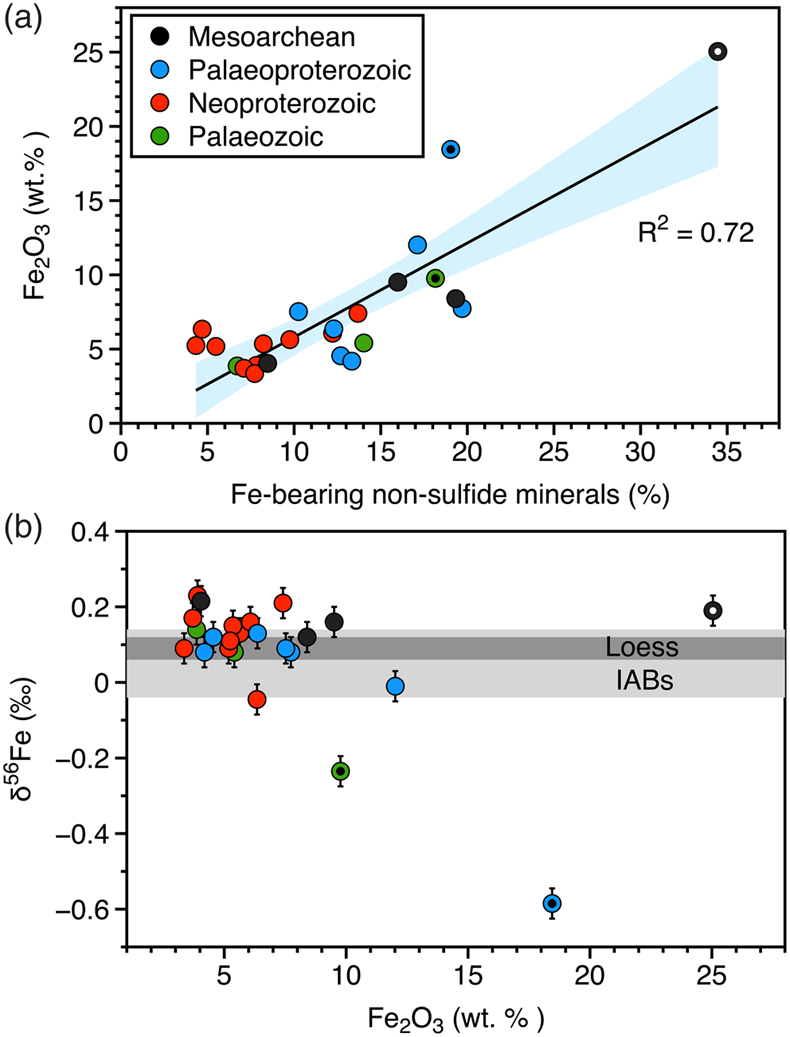
Figure 1 (a) Total iron content (Fe2O3, wt. %) vs. Fe-bearing non-sulfide minerals (%) in all glacial diamictite composites. (b) Plot of δ56Fe vs. total iron content (Fe2O3, wt. %) in all diamictites. Error bars represent two standard derivations. Black lines denote linear fit with light blue fields indicating 95 % confidence interval of fitting. The horizontal gray bars indicate the UCC values (dark gray, 2σ) calculated from loess (Gong et al., 2017
Gong, Y., Xia, Y., Huang, F., Yu, H. (2017) Average iron isotopic compositions of the upper continental crust: constrained by loess from the Chinese Loess Plateau. Acta Geochimica 36, 125–131. https://doi.org/10.1007/s11631-016-0131-5
) and the juvenile bulk crust values (light gray, 2σ) from IABs (Dauphas et al., 2009Dauphas, N., Craddock, P.R., Asimow, P.D., Bennett, V.C., Nutman, A.P., Ohnenstetter, D. (2009) Iron isotopes may reveal the redox conditions of mantle melting from Archean to Present. Earth and Planetary Science Letters 288, 255–267. https://doi.org/10.1016/j.epsl.2009.09.029
), respectively. Two outliers with distinctive Fe isotope compositions are shown with a black dot in the centre of symbols, whereas the Mozaan sample is marked with a white dot.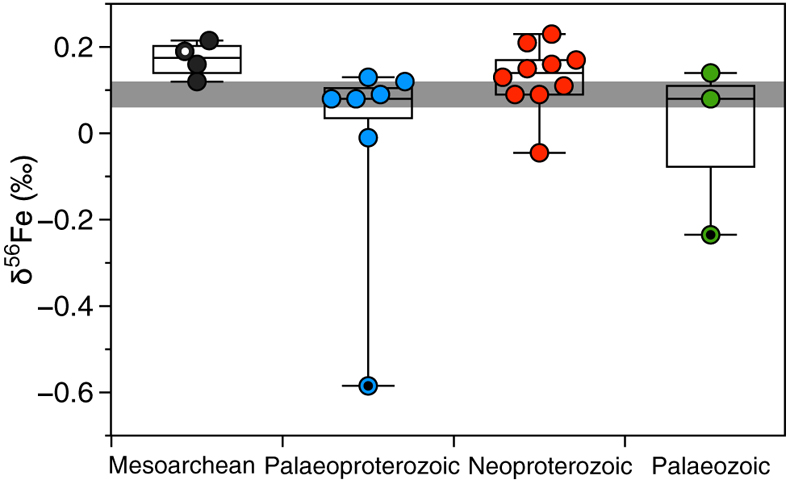
Figure 2 Box and whiskers plot of δ56Fe in diamictite composites of four age groups: the Mesoarchean, Palaeoproterozoic, Neoproterozoic, and Palaeozoic groups. Each individual box includes 50 % of samples and whiskers mark the maximum and minimum of the bin population. The horizontal gray bar indicates the UCC values (2σ) calculated from loess (Gong et al., 2017
Gong, Y., Xia, Y., Huang, F., Yu, H. (2017) Average iron isotopic compositions of the upper continental crust: constrained by loess from the Chinese Loess Plateau. Acta Geochimica 36, 125–131. https://doi.org/10.1007/s11631-016-0131-5
).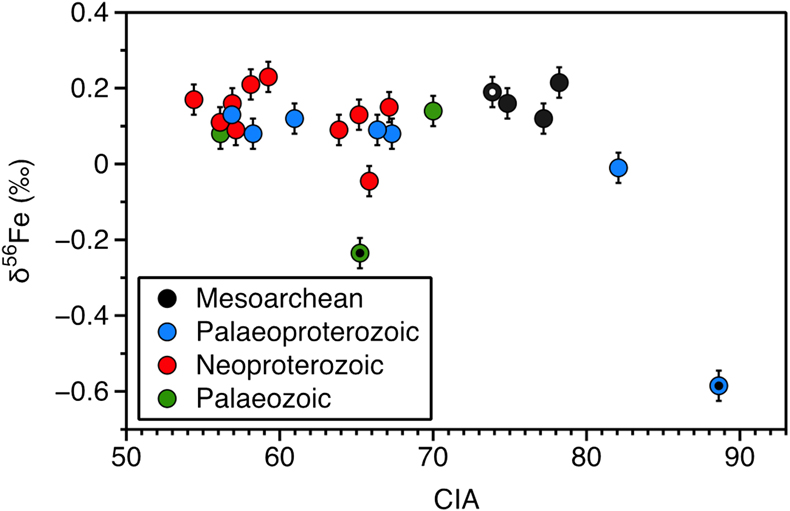
Figure 3 Plot of δ56Fe vs. CIA (chemical index of alteration) in diamictites. CIA is calculated as defined in molar ratio as [Al2O3/(Al2O3 + CaO* + Na2O + K2O)] × 100, where CaO* is corrected to remove the contribution from carbonate and apatite (Nesbitt and Young, 1982
Nesbitt, H.W., Young, G.M. (1982) Early Proterozoic climates and plate motions inferred from major element chemistry of lutites. Nature 299, 715–717. https://doi.org/10.1038/299715a0
). CIA data for diamictite plotted here are from Gaschnig et al. (2016)Gaschnig, R.M., Rudnick, R.L., McDonough, W.F., Kaufman, A.J., Valley, J.W., Hu, Z., Gao, S., Beck, M.L. (2016) Compositional evolution of the upper continental crust through time, as constrained by ancient glacial diamictites. Geochimica et Cosmochimica Acta 186, 316–343. https://doi.org/10.1016/j.gca.2016.03.020
.

